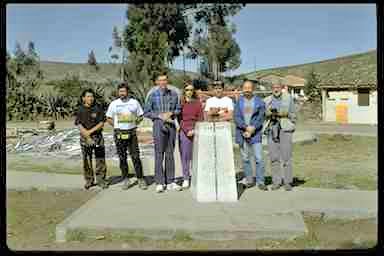
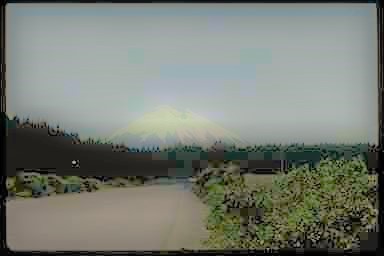
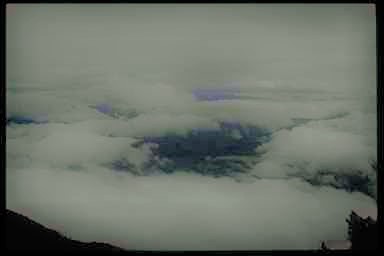
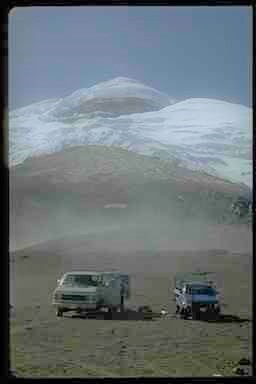
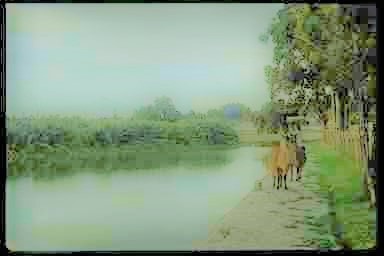

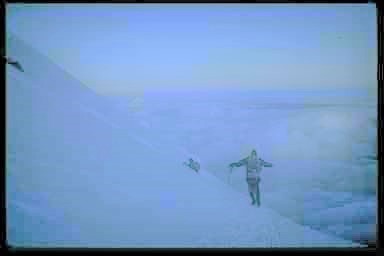
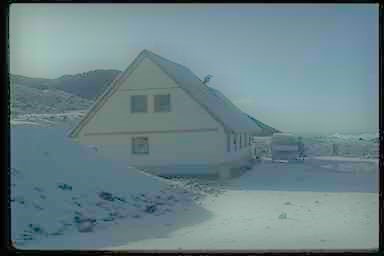
Back to Chronological List of Trips
Back to Home Page
My vacation this year was two weeks of mountain climbing in Ecuador, South America. I left November 6 and returned November 21, flying to and from Quito. While in Ecuador, we attempted to climb three peaks, Tungurahua (16,400), Cotopaxi (19,300) and Chimborazo (20,500).
Our trip leader was Sergio Fitch, the same leader I had on Mt. Elbrus, Russia and Mt. Mera, Nepal.
Tungurahua is an active volcano. On the way to the summit we would have crossed part of the crater. I say "would have" because we didn't make it that far. We got up at 3:30 am and were on our way up the mountain at 4:30. About 7:15 Sergio turned us around and we headed back down to the hut. At the time, we were in fairly high winds and rain or snow. While we weren't having trouble, the conditions weren't optimal. The thinking was to not waste our energy and not get ourselves and our equipment wet trying to get up a minor, warm-up peak.
Cotopaxi is a photogenic and prominent peak in Ecuador. The refugio (hut) is at 15,600. People take day trips from Quito to it. From the parking lot below the hut, it is a 1 hour backpack to it. We were worried because we drove through a heavy rain storm to get there. However, it turned out that our only concern was night coming on. I arrived at 5:30 pm, just as it was getting dark.
We spent 4 nights and 3 days at the hut. The first day we just hung around, acclimatizing. We were going to take short hikes to help our acclimatization but generally the weather wasn't good. The second day we went to the summit. The third day we hung around again because our reservations for vehicles and hotels weren't geared for us coming out a day early.
The day we went to the summit, we got up at 1:00 am and were on our way at 2:00. After about an hour on volcanic ash, we were at the glacier. To get on the glacier, we had to use a technique I had never done before called front-pointing. Crampons (the spikes you strap on to your boots) have a pair of points sticking out in front. We had to use those to climb up about 20 feet or so. Fortunately for me there was a very good climber ahead of me who could belay me in case things didn't go right. We made it up ok.
Once on the glacier and snow, there were a number of steep sections. I became very winded on these sections and a couple of times asked for a minute breathing break. I suspect my problem was acclimatization because I was in at least as good a shape as I was for Mt. Mera 2 years ago which was almost 2,000 feet higher. Anyway, we made the summit at 10:00 am.
Having seen the weather patterns for a couple of days, this day fit right in because at 10:15 the clouds started rolling in. Of course with the clouds came snow. Coming down started getting interesting. The existing snow was getting soft as the day warmed up. Between that and the new snow, footing, even with crampons, started getting difficult.
There is a technique called "self-arrest" which is a way of stopping yourself with an ice ax if you start slipping on ice or snow. You also use this if someone on your rope slips. Until this descent, I had never done a self-arrest for real. I did about 5 or 6 coming down. It was about evenly split across our rope. There were 3 of us on the rope and each of us slipped about twice. The lady on our trip was quite experienced and commented that she had never done so many self-arrests in one day as she did this day.
We finally made it back down to the refugio about 2:30 pm. I had none of the excitement or exhilaration that I had on Mera. While it was a good feeling to make it to the summit, I was too exhausted to really enjoy it. I don't know if I'm getting too old for this, if I was a little under the weather this day, if I wasn't in good enough shape or if I wasn't acclimated enough. Or, maybe this was just a tough mountain and I paid the price it asked.
When we arrived at the hut on Chimborazo, we decided that this mountain was just a legend. We had never seen it up to then. It was always wrapped in clouds.
When we arrived, I had been dealing with a mild case of diarrhea for most of the day. My stomach hadn't been at its best the previous day either. The timing was bad because I had recovered my spirits after the Cotopaxi climb and was ready to take on Chimborazo. However, I still had to recover my strength. The diarrhea kept me from really getting my strength back. It turns out that it didn't matter.
It snowed about 4 inches at the hut our first night there. We would have climbed that night but for the snow. This was fine with me because I knew I wasn't ready to climb that night. A day's delay might be enough for me to get well, recover my strength and do the climb. Again, it didn't matter. Sergio told us that we weren't going to climb. The new snow created too much avalanche danger on the snow face we were to go up. So, we never got above the hut on this mountain.
While 1 out of 3 peaks may not be a great record, this was a very good trip. Sergio is a great leader, we had a great group of people and Ecuador is a wonderful country. I got some very good experience, saw a new country, got to the summit of a major peak and all in all had a great time.
On the third day of the trip we were driving down the highway when a pickup truck passed us. The story I heard was that he swerved to miss a dog and flipped the track. I was on the right side of our van and just heard a loud scrapping sound. Those on the left side said they looked over and saw the under-carriage of the pickup beside us. Our driver didn't realize anything was up until we were part way up the next hill. On stopping we looked back and saw a mangled pickup. Since we didn't have any doctors and there were already plenty of people going to help, we proceeded. However, we missed getting taken out by not very much.
A totally different kind of close call happened at the hut on Tungurahua. The hut can hold maybe 14 people ok. When we came back from our shot at the summit, there were 10 there, our group of 8 and one other couple. About 1:00 p.m. someone showed up and told us that there was a party of 15 French coming up. We packed up and headed down the mountain in no time at all. If we had made the summit, we would have gotten back about the time they showed up and we would have been in no shape to pack up and head down.
The final close call was the last day in Quito. The lady in our group had her handbag sliced open from behind and some cash, her passport, her airline ticket and her credit cards stolen. Before the day was out, she was able to cancel the credit cards and to replace her airline ticket and passport. This happened on Friday. If it all hadn't all come together, she might have been in Quito until at least Tuesday instead of leaving Saturday as scheduled.
Mountain Travel has a trip next year called "The Japan Alps and Mt. Fuji." This sounds like fun. It isn't a major climbing expedition and shouldn't take as much equipment as this trip but still sounds like it could present some challenges. We'll see.







